英语教学教案七年级七篇
- 格式:doc
- 大小:31.77 KB
- 文档页数:27
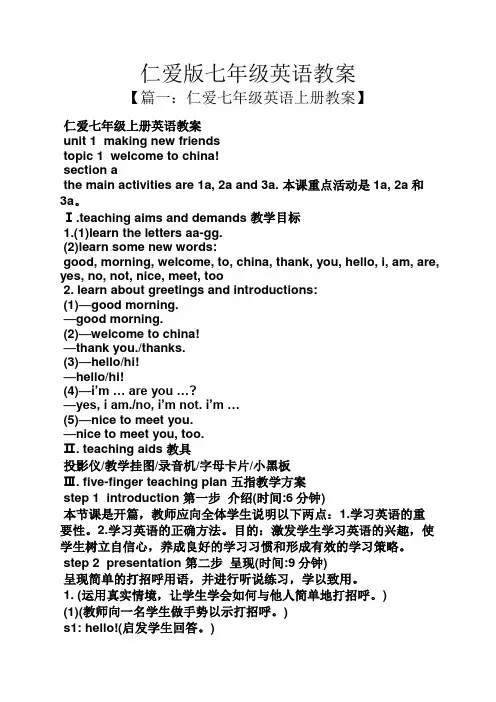
仁爱版七年级英语教案【篇一:仁爱七年级英语上册教案】仁爱七年级上册英语教案unit 1 making new friendstopic 1 welcome to china!section athe main activities are 1a, 2a and 3a. 本课重点活动是1a, 2a和3a。
Ⅰ.teaching aims and demands 教学目标1.(1)learn the letters aa-gg.(2)learn some new words:good, morning, welcome, to, china, thank, you, hello, i, am, are, yes, no, not, nice, meet, too2. learn about greetings and introductions:(1)—good morning.—good morning.(2)—welcome to china!—thank you./thanks.(3)—hello/hi!—hello/hi!(4)—i’m … are you …?—yes, i am./no, i’m not. i’m …(5)—nice to meet you.—nice to meet you, too.Ⅱ. teaching aids 教具投影仪/教学挂图/录音机/字母卡片/小黑板Ⅲ. five-finger teaching plan 五指教学方案step 1 introduction 第一步介绍(时间:6分钟)本节课是开篇,教师应向全体学生说明以下两点:1.学习英语的重要性。
2.学习英语的正确方法。
目的:激发学生学习英语的兴趣,使学生树立自信心,养成良好的学习习惯和形成有效的学习策略。
step 2 presentation 第二步呈现(时间:9分钟)呈现简单的打招呼用语,并进行听说练习,学以致用。
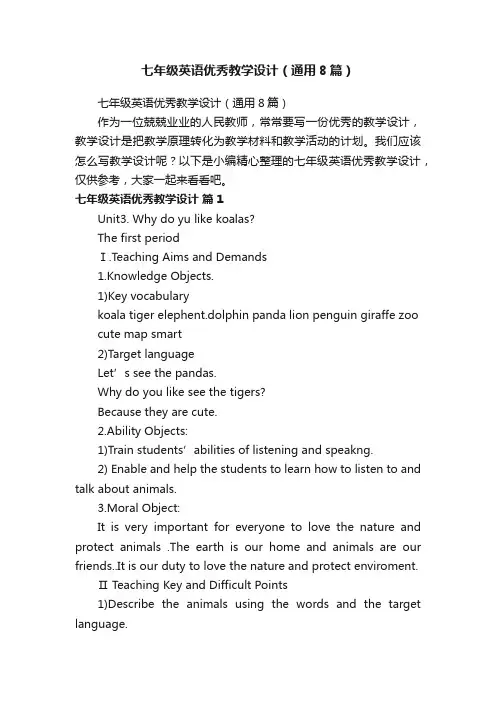
七年级英语优秀教学设计(通用8篇)七年级英语优秀教学设计(通用8篇)作为一位兢兢业业的人民教师,常常要写一份优秀的教学设计,教学设计是把教学原理转化为教学材料和教学活动的计划。
我们应该怎么写教学设计呢?以下是小编精心整理的七年级英语优秀教学设计,仅供参考,大家一起来看看吧。
七年级英语优秀教学设计篇1Unit3. Why do yu like koalas?The first periodⅠ.Teaching Aims and Demands1.Knowledge Objects.1)Key vocabularykoala tiger elephent.dolphin panda lion penguin giraffe zoo cute map smart2)Target languageLet’s see the pandas.Why do you like see the tigers?Because they are cute.2.Ability Objects:1)Train students’abilities of listening and speakng.2) Enable and help the students to learn how to listen to and talk about animals.3.Moral Object:It is very important for everyone to love the nature and protect animals .The earth is our home and animals are our friends..It is our duty to love the nature and protect enviroment.Ⅱ Teaching Key and Difficult Points1)Describe the animals using the words and the target language.2)Get students to learn “Why questions”, “Because answers” a nd the adjectives of quality.Ⅲ.Teaching methods1)Watching and describing methods2) Oral practicing method.Ⅳ.Teaching Aids:1)objects and some pictures.2)A recorder and computerⅤ.Teaching proceduresStep1.Warming up1) Play the tape,get the students to listen to music of animals2) Play a guessing game.T: Listening to the voices of animals.What kinds of animals are they?3) Show some pictures about animals after guessing and talk about animals.T: Look,there is a big zoo in our city There are many animals init.Do you want to see the animals in the zoo?Let’s go into thezoo.What kind of animals can you see?Step2.Present the new words1) T: Look. What is this in Chinese?Ss:“考拉”T: What is this in English?Do you know?Ss: NoT: It is a koala. Read after me K-O-A-L A, koala.2)Show some new words in the pictures.and teach students to learn them.:koala tiger elephent.dolphin panda lion penguin giraffezoo cute map smartStep3. Practice the new words(1a)1)Get students to read the words in 1a2)Match the words with the animals in the oictures.3)After that check the answers.Step4. Task1) Look at the pictures of animals and describe the animals like this. T: Let’s see the pandas .Do you like them?S1: Yes.I like them very much.T: Why do you like them?S1: Because they are cute .Let’s see the lions.T: Why do you want to see the lions.?S1: Because they are smart.T: Do they live on the land or in the water?S1: They live on the land.(At the same time,Teach the students the words,smart,cute)2)Get students to come up wth more new adjectives of quality to describe the animals.cute, smart, fun, interesting, scary, shy, lazy.(At this time,we can also let the students have a competition.This method can make the students active in class and it can help them develop their quick response and wide thinking)3)Get students to ask and answer in pairs to descibe the animals.4)Get students to performin in front of the class.Step5. Listening1)Play the tape,get students to listen and check.the animals in 12)Play the tape again.Ask students to work in pairs.Studentslisten and repeat after the recording3)Check the answer.Step6. Pairwork1)Ask the students to make conversations in pairs. Show the followng.A:Let’s see the elephant.B:Why do you want to see the elephant?A:Because they are very smart.(T:Now please make conversations in pairs ,using the animals in Activity 1c.You can have a competition and let’s see which pair of students is the best?)2)Get a few pairs to show their conversations.Step7 SummaryToday we have learnt lots of new words of animals,and the target language.We can describe the animals and other things using the target language.Now,We should remember the earth is our home and animals are our friends. It is our duty to protect animals and love the nature. Step8 Homework.1)Make a survey:What animals do you like?why?2)Write them down and make a conversationVI Blackboard design七年级英语优秀教学设计篇2一、教学目标:1. 语言知识目标:1) 能掌握以下单词:guitar, sing, swim, dance, chess, play chess, draw, speak, speak English, join, club能掌握以下句型:① —Can you play the guitar? —Yes, I can./ No, I can't.② —What can you do? —I can dance.③ —What club do you want to join? —I want to join the chess club.2) 能了解以下语法:情态动词can的用法want to do sth.的用法2. 情感态度价值观目标:该部分内容贴近学生的生活,谈论的话题是能力。
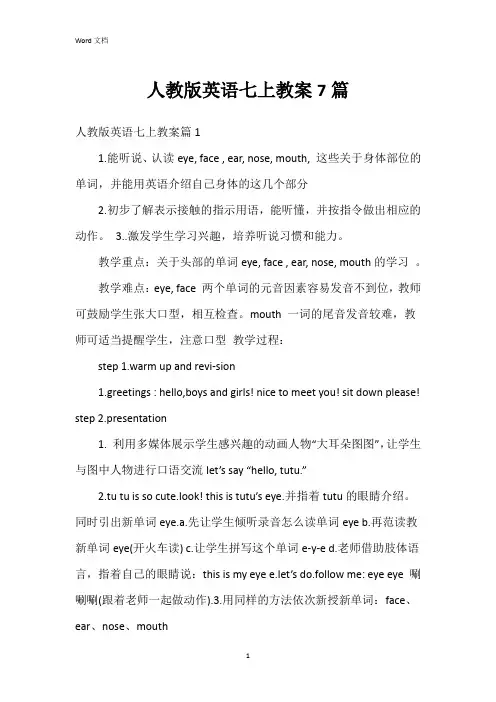
人教版英语七上教案7篇人教版英语七上教案篇11.能听说、认读eye, face , ear, nose, mouth, 这些关于身体部位的单词,并能用英语介绍自己身体的这几个部分2.初步了解表示接触的指示用语,能听懂,并按指令做出相应的动作。
3..激发学生学习兴趣,培养听说习惯和能力。
教学重点:关于头部的单词eye, face , ear, nose, mouth的学习。
教学难点:eye, face 两个单词的元音因素容易发音不到位,教师可鼓励学生张大口型,相互检查。
mouth 一词的尾音发音较难,教师可适当提醒学生,注意口型教学过程:step 1.warm up and revi-sion1.greetings : hello,boys and girls! nice to meet you! sit down please! step2.presentation1. 利用多媒体展示学生感兴趣的动画人物“大耳朵图图”,让学生与图中人物进行口语交流let’s say “hello, tutu.”2.tu tu is so cute.look! this is tutu’s eye.并指着tutu的眼睛介绍。
同时引出新单词eye.a.先让学生倾听录音怎么读单词eye b.再范读教新单词eye(开火车读) c.让学生拼写这个单词e-y-e d.老师借助肢体语言,指着自己的眼睛说:this is my eye e.let’s do.follow me: eye eye 唰唰唰(跟着老师一起做动作).3.用同样的方法依次新授新单词:face、ear、nose、mouth4.powerpoint制作:打开幻灯片后每点击一身体部位就会出现相应的单词。
(注mouth一词的尾音发音较难,适当提醒学生,注意口型。
)5.认读face、ear、eye、nose、mouth的单词卡片和图片。
step3:practice1.let’s do: eye eye 唰唰唰ear ear 呼呼呼nose nose 闻闻闻mouth mouth 巴巴巴face face 拍拍拍2.i say you do.(老师说,学生快速做相应的动作,然后找一位学生出来做出动作。
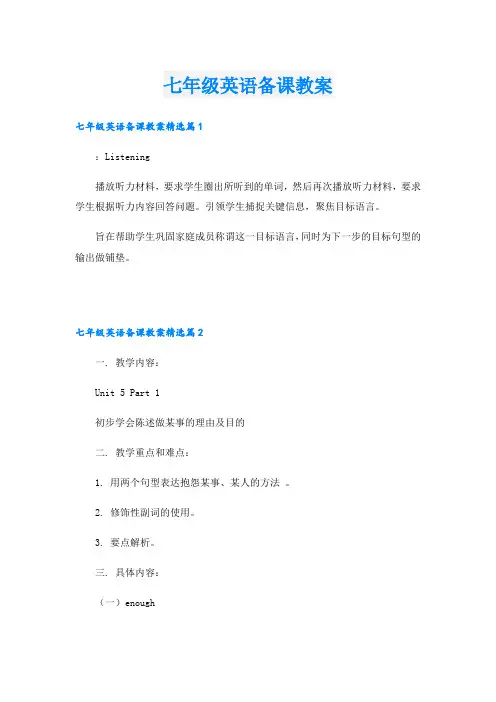
七年级英语备课教案七年级英语备课教案精选篇1:Listening播放听力材料,要求学生圈出所听到的单词,然后再次播放听力材料,要求学生根据听力内容回答问题。
引领学生捕捉关键信息,聚焦目标语言。
旨在帮助学生巩固家庭成员称谓这一目标语言,同时为下一步的目标句型的输出做铺垫。
七年级英语备课教案精选篇2一. 教学内容:Unit 5 Part 1初步学会陈述做某事的理由及目的二. 教学重点和难点:1. 用两个句型表达抱怨某事、某人的方法。
2. 修饰性副词的使用。
3. 要点解析。
三. 具体内容:(一)enough1. enough修饰形容词或副词时必须位于被修饰的词语之后。
修饰名词时一般位于其前,也可位于其后。
enough后面通常接不定式短语或介词for短语。
e.g. The question is easy enough.Tom didn’t do his homework carefully enough.The water is cool enough to drink.We have enough tickets for all of you.2. 修饰形容词时,如果用于否定句,则否定句在否定enough的同时,也否定了其后的不定式。
e.g He is not careful enough to do the work.She is not old enough to go to school.enough如果修饰名词,用于否定句时,不定式没有被否定之意。
e.g. There were not enough people to pick the apples.3. enough也可以做代词,意思是“足够,充足”。
e.g. We have enough to do to complete the project.(二)too…to…too+形容词或副词+(for sb.)+to do 表示“太……以至于不能……”,不定式虽然是肯定形式,但与前面的搭配构成了否定的含义。

七年级上册英语教案人教版免费(经典版)编制人:__________________审核人:__________________审批人:__________________编制单位:__________________编制时间:____年____月____日序言下载提示:该文档是本店铺精心编制而成的,希望大家下载后,能够帮助大家解决实际问题。
文档下载后可定制修改,请根据实际需要进行调整和使用,谢谢!并且,本店铺为大家提供各种类型的经典范文,如工作总结、述职报告、策划方案、演讲致辞、合同协议、条据文书、教案资料、好词好句、作文大全、其他范文等等,想了解不同范文格式和写法,敬请关注!Download tips: This document is carefully compiled by this editor. I hope that after you download it, it can help you solve practical problems. The document can be customized and modified after downloading, please adjust and use it according to actual needs, thank you!Moreover, our store provides various types of classic sample essays for everyone, such as work summaries, job reports, planning plans, speeches, contract agreements, doctrinal documents, lesson plans, good words and sentences, complete essays, and other sample essays. If you want to learn about different sample formats and writing methods, please pay attention!七年级上册英语教案人教版免费最新七年级上册英语教案人教版免费(8篇)作为一位不辞辛劳的人·民教师,通常会被要求编写教案,那么关于七年级上册英语教案怎么写呢?以下是本店铺准备的一些七年级上册英语教案人教版免费,仅供参考。
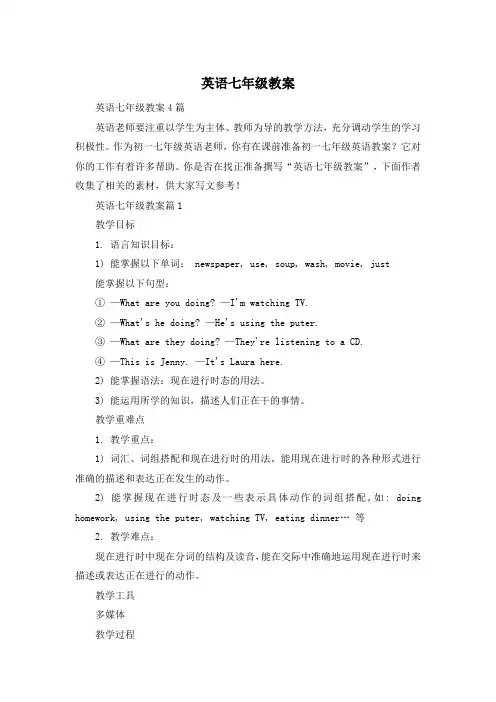
英语七年级教案英语七年级教案4篇英语老师要注重以学生为主体、教师为导的教学方法,充分调动学生的学习积极性。
作为初一七年级英语老师,你有在课前准备初一七年级英语教案?它对你的工作有着许多帮助。
你是否在找正准备撰写“英语七年级教案”,下面作者收集了相关的素材,供大家写文参考!英语七年级教案篇1教学目标1. 语言知识目标:1) 能掌握以下单词: newspaper, use, soup, wash, movie, just能掌握以下句型:① —What are you doing? —I'm watching TV.② —What's he doing? —He's using the puter.③ —What are they doing? —They're listening to a CD.④ —This is Jenny. —It's Laura here.2) 能掌握语法:现在进行时态的用法。
3) 能运用所学的知识,描述人们正在干的事情。
教学重难点1. 教学重点:1) 词汇、词组搭配和现在进行时的用法。
能用现在进行时的各种形式进行准确的描述和表达正在发生的动作。
2) 能掌握现在进行时态及一些表示具体动作的词组搭配,如: doing homework, using the puter, watching TV, eating dinner… 等2. 教学难点:现在进行时中现在分词的结构及读音,能在交际中准确地运用现在进行时来描述或表达正在进行的动作。
教学工具多媒体教学过程Ⅰ. Warming-up and Lead in1. Greet the Ss and check the homework.2. Watch a video program.Ⅱ. Presentation1. Show some pictures on the big screen. Present the new words and expressions.2. Ss watch and learn the new words and expressions.3. Give Ss some time and try to remember the new words and expressions.4. (Show some pictures on the screen and ask some students to perform the actions.). T: What are you doing?S: I am doing homework. (Help him to answer)T: What is he doing?Ss: He is doing homework.Teach: watching TV, cleaning, reading a book, eating dinner, talking on the phone.. the same way.5. Work on 1a. Ss read the activities and look at the pictures. Then match the activities with pictures.6. Check the answers with the Ss.Ⅲ. Game (guess)1. T: Now let's play a game. What's she doing? You must watch the big screen carefully.(Show some pictures on the big screen quickly) Let Ss guess what's he is doing?2. Ss watch and guess the actions.3. Ask and answer about the pictures.—What's he doing?—He's's …Ⅳ. Listening1. T: What are Jenny, John, Dave and Mary doing? Now let’s listen to the tape, find out the right activities from 1a.2. Play the recording for the Ss twice.3. Ss listen to the recording and write the numbers from 1a.Ⅴ. Pair work1. Ask the Ss to read the conversations in 1c with a partner. Then look at the pictures in 1a. And conversations about other person in the picture.2. Ss make conversations by themselves and practice the conversations.Ⅵ. Listening1. Work on 2a;T: Jack and Steve are talking on the phone. What are they doing now? Listen to the conversations and match the answers with the questions. (Play the recording for the first time, students only listen carefully. Then, listen to the recording again, and match the answers with the questions. )Check the answers.2. Work on 2b.Let Ss read the conversation in 2b first. Then play the recording for the Ss twice.The first time Ss only listen and write down the words in the blanks. Then play the recording again for the Ss to check the answers. (If necessary, press the Pause button to help.)Ⅶ. Pair work1. Now, role-play the conversation with your partners.2. Let some pairs to act out the conversation in front of the class.Ⅷ. Role-play1. Ask Ss to read the conversation in 2d and answer the questions below.① Are Jenny and Laura talking on the phone?(Yes, they are.)② What's Laura doing now?(She's washing her clothes.)③ What's Jenny doing?(She's watching TV.)④ When do they meet at Jenny's home?(At half past six.)2. Ss read the conversation and answer the questions above.3. Check the answers with the Ss.4. Let Ss work in pairs and role-play the conversation.Homework:1. Review the words and expressions in this period.2. Understand the knowledge about the present progressive tense.3. Make five sentences on what are you doing now.英语七年级教案篇2Language Goal:Talk about what people are doing.Teaching Aims:The present Progressive (结构式: Be + V-ing )Key Points:#What’s he doing ?#He’s reading.Difficult points:现在进行时的用法和动词V-ing 形式的构成。
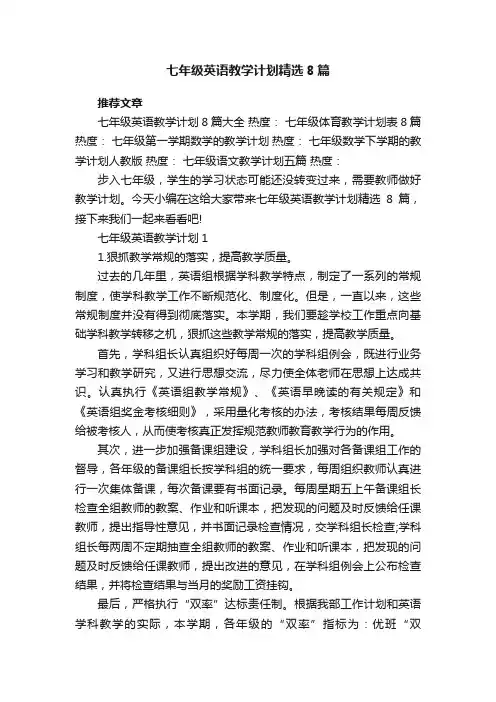
七年级英语教学计划精选8篇推荐文章七年级英语教学计划8篇大全热度:七年级体育教学计划表8篇热度:七年级第一学期数学的教学计划热度:七年级数学下学期的教学计划人教版热度:七年级语文教学计划五篇热度:步入七年级,学生的学习状态可能还没转变过来,需要教师做好教学计划。
今天小编在这给大家带来七年级英语教学计划精选8篇,接下来我们一起来看看吧!七年级英语教学计划11.狠抓教学常规的落实,提高教学质量。
过去的几年里,英语组根据学科教学特点,制定了一系列的常规制度,使学科教学工作不断规范化、制度化。
但是,一直以来,这些常规制度并没有得到彻底落实。
本学期,我们要趁学校工作重点向基础学科教学转移之机,狠抓这些教学常规的落实,提高教学质量。
首先,学科组长认真组织好每周一次的学科组例会,既进行业务学习和教学研究,又进行思想交流,尽力使全体老师在思想上达成共识。
认真执行《英语组教学常规》、《英语早晚读的有关规定》和《英语组奖金考核细则》,采用量化考核的办法,考核结果每周反馈给被考核人,从而使考核真正发挥规范教师教育教学行为的作用。
其次,进一步加强备课组建设,学科组长加强对各备课组工作的督导,各年级的备课组长按学科组的统一要求,每周组织教师认真进行一次集体备课,每次备课要有书面记录。
每周星期五上午备课组长检查全组教师的教案、作业和听课本,把发现的问题及时反馈给任课教师,提出指导性意见,并书面记录检查情况,交学科组长检查;学科组长每两周不定期抽查全组教师的教案、作业和听课本,把发现的问题及时反馈给任课教师,提出改进的意见,在学科组例会上公布检查结果,并将检查结果与当月的奖励工资挂钩。
最后,严格执行“双率”达标责任制。
根据我部工作计划和英语学科教学的实际,本学期,各年级的“双率”指标为:优班“双率”100%;myp班“双率”100%;平行班及格率97%以上,优秀率85%以上。
为了达到“双率”指标,我们采取任课教师、备课组长、学科组长共同负责的责任制,把班级、年级和学科的“双率”是否达标分别与任课教师、备课组长、学科组长的奖励工资挂钩,并作为他们工作业绩考核的重要指标。
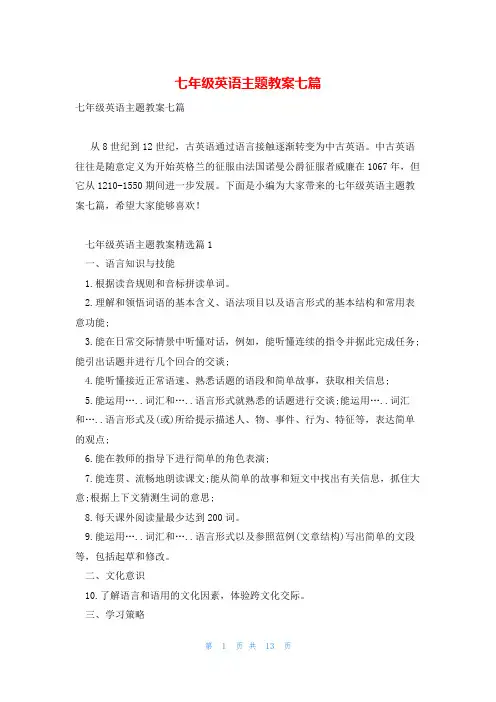
七年级英语主题教案七篇七年级英语主题教案七篇从8世纪到12世纪,古英语通过语言接触逐渐转变为中古英语。
中古英语往往是随意定义为开始英格兰的征服由法国诺曼公爵征服者威廉在1067年,但它从1210-1550期间进一步发展。
下面是小编为大家带来的七年级英语主题教案七篇,希望大家能够喜欢!七年级英语主题教案精选篇1一、语言知识与技能1.根据读音规则和音标拼读单词。
2.理解和领悟词语的基本含义、语法项目以及语言形式的基本结构和常用表意功能;3.能在日常交际情景中听懂对话,例如,能听懂连续的指令并据此完成任务;能引出话题并进行几个回合的交谈;4.能听懂接近正常语速、熟悉话题的语段和简单故事,获取相关信息;5.能运用…..词汇和…..语言形式就熟悉的话题进行交谈;能运用…..词汇和…..语言形式及(或)所给提示描述人、物、事件、行为、特征等,表达简单的观点;6.能在教师的指导下进行简单的角色表演;7.能连贯、流畅地朗读课文;能从简单的故事和短文中找出有关信息,抓住大意;根据上下文猜测生词的意思;8.每天课外阅读量最少达到200词。
9.能运用…..词汇和…..语言形式以及参照范例(文章结构)写出简单的文段等,包括起草和修改。
二、文化意识10.了解语言和语用的文化因素,体验跨文化交际。
三、学习策略11-(1)利用读音规则和音标拼读词汇,利用上下文、非语言信息等理解词义,联想学习和记忆词汇,构词法等。
11-(2)利用情境等理解语法结构和表意功能,发现语言规律并举一反三。
11-(3)复习、整理归纳所学内容。
11-(4)利用预测、语调、重音、问题等来获取听力信息。
11-(5)在课内外活动中借助体态语用英语交流。
11-(6)利用预测、跳读、寻读、细节读等来获取文章信息。
11-(7)仿写短文,准备素材、起草短文并修改。
11-(8)明确目标,制定计划,11-(9)了解并跨文化交际(恰当使用)。
四、情感态度12.乐于参与英语活动,敢于用英语表达,积极与他人合作,体验自己的学习效果。
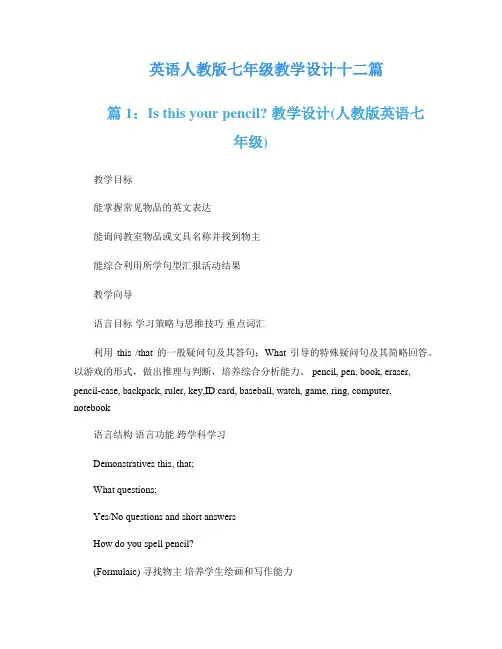
英语人教版七年级教学设计十二篇篇1:Is this your pencil? 教学设计(人教版英语七年级)教学目标能掌握常见物品的英文表达能询问教室物品或文具名称并找到物主能综合利用所学句型汇报活动结果教学向导语言目标学习策略与思维技巧重点词汇利用this /that 的一般疑问句及其答句;What 引导的特殊疑问句及其简略回答。
以游戏的形式,做出推理与判断,培养综合分析能力。
pencil, pen, book, eraser, pencil-case, backpack, ruler, key,ID card, baseball, watch, game, ring, computer, notebook语言结构语言功能跨学科学习Demonstratives this, that;What questions;Yes/No questions and short answersHow do you spell pencil?(Formulaic) 寻找物主培养学生绘画和写作能力主题词表pencil, pen, book, eraser, pencil-case, backpack, ruler, key, ID card, baseball, watch, game, ring, computer, notebookExtensive words:textbook; exercise-book; ball-pen; compass; sharpener; rubber; glue; color-pen; sticker; highlight; ball-point; scissors; chalk; file; blackboard; ink; set- square; paper; pamphlet; peg.重点句型(1)Is this your pencil? Yes, it is./No, it isn’t.(2)Is that my book? Yes, it is./ No, it isn’t.(3)Is this/that her/his eraser? Yes, it is./ No, it isn’t.(4)What’s this/ that in English? It’s a/an ……(5)How do you spell pen? P-E-N.主题思维图及任务型活动课前准备让学生收集并自学有关文具或教室物品的名词,并准备一些实物或图片。
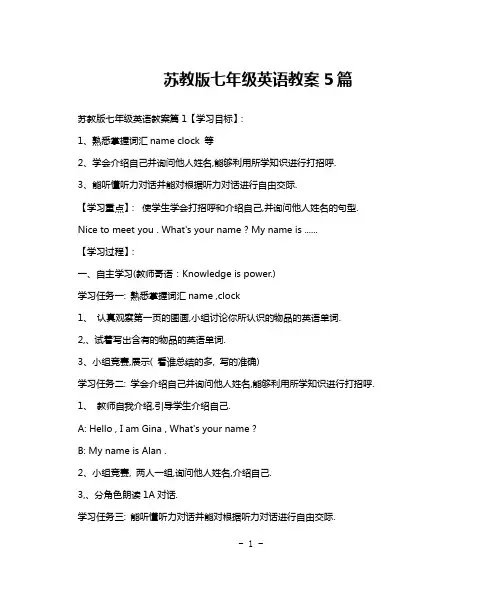
苏教版七年级英语教案5篇苏教版七年级英语教案篇1【学习目标】:1、熟悉掌握词汇name clock 等2、学会介绍自己并询问他人姓名,能够利用所学知识进行打招呼.3、能听懂听力对话并能对根据听力对话进行自由交际.【学习重点】:使学生学会打招呼和介绍自己,并询问他人姓名的句型. Nice to meet you . What's your name ? My name is ......【学习过程】:一、自主学习(教师寄语:Knowledge is power.)学习任务一: 熟悉掌握词汇name ,clock1、认真观察第一页的图画,小组讨论你所认识的物品的英语单词.2,、试着写出含有的物品的英语单词.3、小组竞赛,展示( 看谁总结的多, 写的准确)学习任务二: 学会介绍自己并询问他人姓名,能够利用所学知识进行打招呼.1、教师自我介绍,引导学生介绍自己.A: Hello , I am Gina , What's your name ?B: My name is Alan .2、小组竞赛, 两人一组,询问他人姓名,介绍自己.3,、分角色朗读1A对话.学习任务三: 能听懂听力对话并能对根据听力对话进行自由交际.1,、听录音, 给1B 的对话编号.2、根据听力对话进行自由交际.3、小组竞赛, 展示对话交际。
二、合作共建(教师寄语:Many hands make light work. )小组讨论我们所学的英语名字和汉语名字的区别, 如何用英语拼写你的名字?三、系统总结(教师寄语:No man can do two things at once.) 1,、归纳你所学到的问候语.2、自己编写一个打招呼并询问姓名的小对话.四、诊断评价(一) 单项选择.1. _______your name ? My name is Gina .A. WhatB. What'sC. WhoD. which2. Good morning , Miss Wang ! _____________!A. HelloB.HiC. Nice to meet youD. Good morning3. I _______Sally , What______ your name ?A. am ,isB. is , amC. is , isD.am, am4. ______name is Li lei .A. IB. I amC. MyD. you5.—_______, What's your name ?—John Green .A. HiB. OkC. sorryD. Excuse me(二) 写出下列单词的完全形式, 并写出汉语意思.I'm _________ __________ what's __________ ________name 's ___________ __________(三)写出下列单词.时钟_______ 我的________ 你的___________ 名字_______ 遇见_________(四)尝试翻译下列句子.1. 见到你很高兴. _________________________________.2.我叫王小雨. ____________________________________.3. 你叫什么名字? ____________________________________(五) 根据情景补全对话.A: Good afternoon !B: ____________________!A; I ______Lucy . _________your name ?B: My ______ is Jim . Nice to ______you !A: _______________________________.五、【课后反思】苏教版七年级英语教案篇2教学目标Key words: short, curly, long, tall, straight hair, a medium build, thin, heavy, bald; brown, blonde;glasses, hair, beard, mustache.New language:What do you look like? I’m short. And I have curly hair.What do they look like? They’re medium height. And they have short hair.What does he look like? He’s heavy and he wears glasses.What does she look like? She’s thin and she has long hair.教学重难点Importance: Describing people. Such as tall or short…and who has long hair and short hair…Difficulties: use the sentences correctly to describe the physical appearance.III. Teaching Steps:教学工具课件教学过程Step 1 GreetingsStep 2 Ask some students to name some ways of describing people. Start students off with examples such as tall and short. Point out various students in the class and ask students to say if they are tall or short.Step 3 Some new words about this part(1a) This activity introduces the key vocabulary. Ask students to read the list of words. Point to the letters next to the people in the picture. Point out the sample answer. At last, check the answers.(1b) This activity provides guided listening and writing practice the target language.Play the recording the first time, then , play it again, this time, students fill in theblanks in the speech bubbles.Correct the answers.Language points: 1.He’s the tall boy with the curly hair.(1c)This activity provides guided oral practice using the target language. Ask the students to ask and answer the questions. Then have students work in pairs. As they talk, move around the room monitoring their work.Language points:2.What does your friend look like?你的朋友长得什么样?look like “看起来像,看起来是……的样子”like 作介词,意为“像….”eg. What’s he like?Jack is very like his father.look like 看起来像The girl look like her mother.look 看起来后加形容词作表语His sister looks happy.look the same 看起来很像The twins look the same.(2a)This activity provides guided listening practice using the target language.Point to the list of nice phrases and ask a students to read them to the class. Play the recording twice. And complete the answers. Then correct the answers.(2b)Ask the students to listen to the descriptions and write the words in the correct column after each person’s name.(3)Writing practice: Have students do the activity individually. Offer help as necessary.(Grammar focus) Review the grammar box. Ask students to read the questions andanswers. Point out: ①does, goes-----you, they do, go--------he, she.②I’m, they’re, he’s and she’s -----height(3a)This activity provides reading practice using the target language. Have a student read the first description. Check the answers.Language points:3.She has a medium build, and she has long hair. 她体格中等,留着长发。
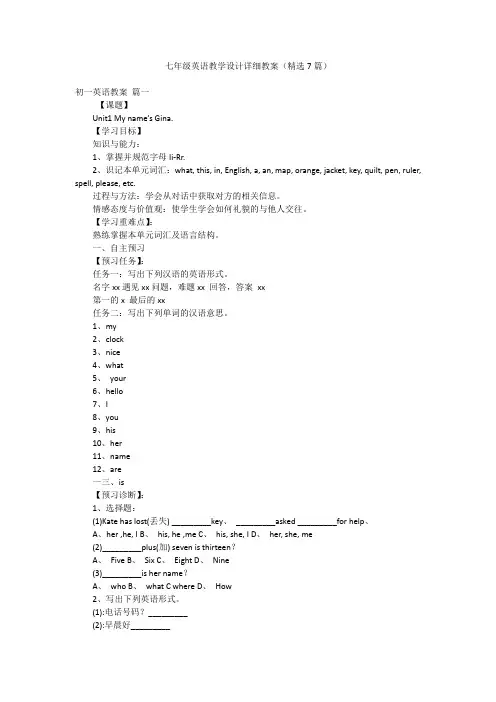
七年级英语教学设计详细教案(精选7篇)初一英语教案篇一【课题】Unit1 My name’s Gina.【学习目标】知识与能力:1、掌握并规范字母Ii-Rr.2、识记本单元词汇:what, this, in, English, a, an, map, orange, jacket, key, quilt, pen, ruler, spell, please, etc.过程与方法:学会从对话中获取对方的相关信息。
情感态度与价值观:使学生学会如何礼貌的与他人交往。
【学习重难点】:熟练掌握本单元词汇及语言结构。
一、自主预习【预习任务】:任务一:写出下列汉语的英语形式。
名字xx遇见xx问题,难题xx 回答,答案xx第一的x 最后的xx任务二:写出下列单词的汉语意思。
1、my2、clock3、nice4、what5、your6、hello7、I8、you9、his10、her11、name12、are一三、is【预习诊断】:1、选择题:(1)Kate has lost(丢失) _________key、_________asked _________for help、A、her ,he, IB、his, he ,meC、his, she, ID、her, she, me(2)_________plus(加) seven is thirteen?A、FiveB、SixC、EightD、Nine(3)_________is her name?A、whoB、what C where D、How2、写出下列英语形式。
(1):电话号码?_________(2):早晨好_________(3):下午好_________3、写出下列词的英语意思:1)、早晨_________2)、下午_________3)、晚上_________4)、谢谢_________5)、名字_________6)、好的_________or_________【预习反思】:你还有什么问题吗?(Do you have any problems?)二、课中实施Step1 交流展示Step2 精讲点拨:What’s your name?你叫什么名字?句中的your可根据问对象换成his、her等物主代词。
七年级英语教学计划13篇七年级英语教学计划篇1一、指导思想:坚持“教书育人,为师”的教育宗旨,关心每一个学生的发展,热爱岗位,努力工作,以身作则。
使学生了解英语在当今社会中的重要性,增强学生的世界观和人生观,使学生初步形成健全的合格学生,成为对社会有用的人。
二、学生情况分析:我教第七年级新生的基础很差。
由于他们在小学英语课上没有得到足够的重视,学生们基本上没有接受过写作技能的训练,甚至连语音口语都没有,甚至有一半的学生还没有掌握26个字母的拼写。
通过上学期我和学生们的不懈努力,他们的基础知识得到了加强,学习态度得到了改善。
一些学生有积极学习的动机,但整体惯性仍然很强。
我要有进取心,主动帮助他们重建学习兴趣。
此外,学生还需要进一步理解和掌握学习策略。
许多学生不清楚学习英语的目的,也没有真正意识到学习英语的目的是交流。
一些学生在学习中缺乏小组合作意识,不愿意与其他学生交流,不能共同完成学习任务。
大多数学生不能做好课前准备和课后复习。
他们的学习没有计划,完全在老师的指挥棒下学习,没有总结语言规律、巩固和积累知识的能力。
这些都是我和我的学生必须长期奋斗并努力解决的'问题。
我会慢慢地给学生信心去完成这些任务。
急也没用。
解决问题的关键是让学生乐于理解我的教学指导,找到自己的路。
三、教材分析:本书主要介绍日常生活中的交际用语以及一些西方国家的文化背景和风俗习惯。
教材通俗易懂,旨在使7年级学生基本上能用英语进行交流。
本书由两部分组成,即准备部分(3单元)和正式部分(9单元)。
除了提供语言材料外,这本书还配有许多插图和录音带。
四、教学目标通过努力,每个学生都能说英语,并能用英语进行简单的对话。
通过努力,大多数学生继续坚持他们学习英语的兴趣。
能坚持学习英语的浓厚兴趣和进取心,积极参与实践,从点到面,努力达到学校教学质量的要求。
五、教学措施和方法措施:1、培养学生的学习兴趣,引导学生掌握正确的学习方法和策略,提高学习效率2、发挥学生主体和教师主导作用:3、以良好的师生关系协调课堂气氛,培养学生讲英语的勇气和信心4、引导学生实现语言迁移,加强日常生活中英语口语的运用5、鼓励学生独立、联合和共同探索。
七年级英语教学方案优质范例5篇翻开各类教育报刊杂志,我们不难发现到处都在谈“新课程”,并极力提倡在教学中采用“新课标”,课改的浪潮再次波涛汹涌。
今天小编为大家带来了七年级英语教学方案优质范例,希望可以帮助到大家。
七年级英语教学方案优质范例一一、学生情况分析及对策经过一学期的学习,从上期期末成绩来看,两个班的英语成绩很不理想。
七年级1班、2班60分以上分别都是3人;在两个班里优生只有一个。
两极分化还是比较明显。
一些学生学习目的明确,态度端正,掌握了英语学习的一些基本方法,能够积极主动认真地学习,学习成绩较好。
但还有大部分学生没有明确的学习目的,缺少学习的热情和主动性,自觉性较差,相应的学习习惯也差。
主要原因是没有激发学生学习英语的兴趣,学生觉得英语学习是一种负担,而不是一种乐趣。
一部分学生没有掌握记忆单词的方法,连基本的单词听写也不过关,导致看不懂,听不懂,学不懂。
针对种.种问题,在本期的英语教学中,教师一方面应加强基础知识的讲解和基本技能的训练,让学生掌握词汇、语法、句型等基础知识和听、说、读、写等基本技能,为进一步学习英语打下坚实的基础;另一方面,又要采取多种措施,注意培养学生对英语的兴趣;让学生掌握记忆单词、听音、写作等英语学习技艺,培养良好的学习习惯和自主探索,合作探究能力。
充分调动学生的学习积极性和主动性。
教学上采取任务型教学,运用灵活多变的方法,实现学生语言运用能力的迁移和拓展。
还要注意培养良好的师生关系,尊重理解学生,与学生一起分享学习中的苦与乐。
使每一位学生都能在学习中取得很大成绩,有所进步。
二、教材分析《Go for it》七年级下册共12个单元,再加上两个复习单元。
全书采取任务型语言教学模式,融汇话题、交际功能和语言结构,形成了一套循序渐进的生活化的学习程序。
每个单元都列出明确的语言目标,主要的功能项目与语法结构,需要掌握的基本词汇,并分为A、B 两部分。
A部分是基本的语言内容,B部分是知识的扩展和综合的语言运用。
七年级英语优秀教案多篇2021七年级英语优秀教案1Starter Unit2 what’s this in English? 第1课时section1a-2e 【学习目标】语言目标:字母I—R;辨认物品;拼写单词1.七个表示物体的单词的熟练掌握。
(汉语意思写出来) map orange jacket key quilt pen ruler 确认物体的句型(写出意思):问:What is this in English? 答:It's /a /an/ map/ orange/ jacket/ key/ pen/ ruler/ quilt.3.区分a和an的用法(读书上87页:冠词用法)。
【预习指导】自我预习一、扫清障碍试着用按英语中音标拼读出StarterUnit21a的单词(在书上第94页)。
二、课本预习温故知新1.按照字母顺序正确默写上单元学过的八个字母的大小写。
2.小组合作用英语完成对话。
1)熟识朋友见面的问候语和应答。
——Hello, Frank! ——Hi, Cindy! How are you? ——I'm fine / OK, thanks.2)一天见面打招呼的用语。
__Good morning, Helen!__,Bob! __Good , Eric!__Good afternoon, Grace! __Good evening, Helen!__,Dale!:__Hi, Alice!__Hi, Cindy! __Hello,Frank!__Hello, Dale! 【课内学习】一、教材处理:自主互助学习1.看图认一认1a中认识的字母,并把它写下来。
小组讨论答案,教师巡回检查。
2.看图认物品,努力用英语说出认识的物品,小组比一比,哪一个小组认识的物品多。
二、组内探讨1)看图片或者用实物小组做对话练习。
师生备注2)听1a录音,指出听到的物品。
3)用图中物品,双人自由问答并表演。
人教版七年级上册英语教案16篇人教版七年级上册英语教案(精选篇1)一、复习指导思想新授课结束后,期末考试前,指导学生进行期末复习,主要复习基础知识,提高做题能力,训练阅读、听力与写作,使学生能够举一反三,熟练掌握知识点与考点.二、学生学习水平现状分析学生的主要问题是基础薄弱,做题能力参差不齐,优秀的学生不多,成绩有待于提高的学生比较多,一部分同学学习惰性强。
三、复习时间:十七周至十八周(共10课时)四、复习重点1、基础知识:unit1—unit8:重点词汇、短语、句型2、语法:(1)动词不定式(2)动名词(3)被动语态(4)形容词相关句型的运用(5)副词的运用(6)原因状语从句(7)过去进行时3、阅读训练(报纸阅读材料)4、听力(报纸、导学案套题听力训练)5、话题写作:肢体语言,义务工作,传统技艺,卡通漫画、动物保护、动物描写、未来生活畅想6、复习中注重讲练结合,及时反馈,及时检测五、课时安排时间为两周,具体计划如下:十七周(周一)unit1、2重点词组句型小结;语法训练(报纸2、3版)十七周(周二)unit1、2知识点练习,话题写作训练(报纸4版)十七周(周三)unit3、4重点词组句型小结;语法训练(报纸5、6版)十七周(周四)unit3、4知识点练习,话题写作训练(报纸7版)十七周(周五)unit5、6重点词组句型小结;语法训练(报纸8、9版)十八周(周一)unit5、6知识点练习,话题写作训练(报纸10版)十八周(周二)unit7、8重点词组句型小结;语法训练(报纸11、12版)十八周(周三) unit7、8知识点练习,话题写作训练(报纸13版)十八周(周四)模拟套题(报纸31版)(综合测试一)十八周(周五)模拟套题(报纸32版)(综合测试二)六、复习措施1、单词过关。
每天重点句子听写2、语法复习注重讲练结合,引导学生说出重点与易错点3、加强整理英语学习档案4、对于阅读训练有指导,有检测。
七年级新目标英语教学计划(7篇)七年级新目标英语教学计划1一、、本学期的指导思想:1、整体设计目标,体现灵活开放,目标设计以学生技能,语言知识,情感态度,学习策略和文化意识的发展为基础;2、要面向全体学生,关注每个学生的情感,激发他们学习英语的兴趣,帮助他们建立学习的成就感和自信心,培养创新精神;3、突出学生主体,尊重个体差异;4、采用活动途径,倡导体验参与,即采用任务型的教学模式,让学生在老师的指导下通过感知、体验、实践、参与和合作等方式,实现任务的目标,感受成功;二、所教班级学生基本情况分析:本届七年级新生和以往初一学生有着很大的差异,即他们曾在小学学过一,二年英语。
但由于在小学英语课并未受到足够的重视,他们在写的技能方面基本上没有得到过训练,字母还不能规范的书写,更别提什么单词,句子。
在读,说方面,语音也有不少需要纠正的地方,由于各小学授课,英语基础也差参不齐。
三、奋斗目标:钻研新课标,提高自己的教学水平,真正做到教学相长,努力达到学校规定的教学指标。
四、具体措施:1、每天背诵课文中的对话。
目的:要求学生背诵并默写,培养语感。
2、每天记5个生词,2个常用句子或习语。
实施:利用“互测及教师抽查”及时检查,保证效果并坚持下去。
3、认真贯彻晨读制度:规定晨读内容,加强监督,保证晨读效果。
4、坚持日测、周测、月测的形成性评价制度:对英语学习实行量化制度,每日、每周、每月都要给学生检验自己努力成果的机会,让进步的同学体会到成就感,让落后的同学找出差距,感受压力。
由此在班里形成浓厚的学习氛围,培养学生健康向上的人格和竞争意识。
5、对后进生进行专门辅导,布置单独的作业,让他们在小进步,小转变中体味学习的快乐,树立学习的自信,尽快成长起来。
6、关注学生的情感,营造宽松、民主、和谐的教学氛围。
7、加强对学生学习策略的指导,为他们终身学习奠定基础。
8、要充分利用现代教育技术,利用计算机和多媒体教学软件,探索新的教学模式,开发英语教学资源,拓宽学生学习渠道,改进学生学习方式,提高教学效果。
初一英语学习教案七篇初一英语学习教案七篇初一英语学习教案都有哪些?英语,旨在培养具有良好综合素质、扎实的外语基础技能和专业知识能力,掌握相关专业知识,下面是小编为大家带来的初一英语学习教案,希望大家能够喜欢!初一英语学习教案(精选篇1)一、教学目标:1. 语言知识目标:1) 继续练习运用情态动词can。
学会询问和谈论彼此的能力和特长。
① —Can you play the guitar —Yes, I can./ No, I can t.② —What can you do —I can dance.③ —What club do you want to join2. 情感态度价值观目标:对自身的认识,为将来的自我发展奠定基础。
二、教学重难点1. 教学重点:1) 让学生重点总结、发现情态动词can2)2. 教学难点:1) 情态动词can的用法;2) 在实际交际活动中运用来询问与表达自己或他人的能力。
三、教学过程Ⅰ. Warming- up and revisionT: Hi, S1! What can you doS1: I can sing and dance2. Role-play.Ⅱ1. 2. 中的句子,然后做填空练习。
①② / 不,我不会。
Yes, ____ _______. / No, I _______.… (其余试题见课件部分)3. 学生们完成填空试题后,可以打开课本检查答案,对错误的句子,单独进行强化记忆。
Ⅲ. Try to Find老师将情态动词的can的用法,以学案的方式呈现在大屏幕上,让学生自主学习,并发现其用法。
1. 可以看出,在Can…句型中,情态动词can没有________和_______ 的变化。
2. 用情态动词can来询问他人的能力可以归纳为以下句型:Can + _______ + _________ + 其他肯定回答:_________________否定回答: _________________What + can + _______ + ________学生们合作学习讨论上面学案的答案,总结情态动词can的用法。
英语教学教案七年级七篇英语教学教案七年级【篇1】Unit 3How do yougetto school?Section AThe first period一教学目的:1.学习Section A 中的生词。
2.学习句型:How do yougetto school?3.词组:takethe traintake the bustake the subwayride a bike二、教学重点:同上三、教学难点:本课中生词的拼写。
四、教学过程:Step1Learn the new words.train ,take the train .bustake the bus .subway ,ridebikeride a bikeStep2IntroductionAsk the students like this:How do yougetto school?Then ask some students to answer thisquestion.Step3PracticeMatch the wordswith the pictures1.takethetrain(a)2.take the bus(3.take the subway(e)4.ride a bike(b)5walk(c)Step4ListenListen and write the numbers next to the correct students in the picture aboveStep 5PracticeMake a conversation with your partner about how the students get to schoolFor example :How does LiFei get to school?She takes the subway五、布置作业。
英语教学教案七年级【篇2】初一英语外研版(上)教案 Module 8 Choosing presents一、学习目标: 1.单词和短语:card, party, present, would, always, great, cake, never, special, eat, give, sing, happy, secret, CD, cinema, concert, magazine, scarf, silk, shirt, T-shirt, choose, exercise, wear, expensive, clothes, shoes, spend, money, film, song, match, weekend, at weekends, dear, hear, hear from, afraid2.交际用语:1)—Would you like to come to my birthday party? —Yes, I’d like to.When is it? 2)Great! 3)It’s a secret.3.重点句子:1) Daming always gets birthday presents! 2) She often goes to the cinema.3) What do you usually do at a Chinese birthday party? 4) We sometimes give birthday cards.5) My mother never makes a birthday cake.二、重点及难点:1.频度副词的使用及在句中的位置。
2.动词第三人称单数形式。
三、教学设计: Unit 2 She often goes to concerts.ⅠTeaching model Reading and writing.ⅡTeaching method communicative approach ⅢTeaching aims1.To get information from the reading material about choosing birthday presents.2.To write a description of one’s partner.3.To get to know compound nouns.ⅣTeaching ObjectivesKey vocabulary: CD, cinema, concert, magazine, scarf, silk, shirt, T-shirt, choose, exercise, wear, expensive, clothes, shoes, spend, money, film, song, match, weekend, at weekends ⅤTeaching aids Recorder, OHP, video ⅥTeaching Steps Step 1 Warming-up 1.Review the text of Unit 1.2.Show some pictures, ask the students to look at the pictures, then talk something about the pictures.3.Introduce the new words.4.Read the new words.Step 2 Practice 1.Look at the pictures in Activity 1.2.Read through the list of presents and have the students repeat them after you chorally and individually.3.Match the words with the pictures.4.Check with a partner.5.Call back the answers from the whole cla.Keys:1.a concert ticket2.a magazine3.a silk shirt4.a box of chocolate5.a T-shirt6.a CD7.a scarf8.a cinema ticket9.a football Step 3 Reading.1.Play the recording.2.Ask the students to read through the paage.3.Match the people with what they like doing.4.Check with a partner.5.Call back the answers from the whole cla.Keys: 1.c 2.b 3.d 4.a 5.e6.Choose presents from the pictures in Activities 1 for them.7.Check with a partner.8.Call back the answers from the whole cla.Keys:1.T-shirt2.a silk dre, a scarf, and a box of chocolate3.a magazine and a cinema ticket4.a CD, a concert ticket5.football plete the paage with the correct form of the words from the box.10.Check with a partner.11.Call back the answers from the whole cla.Keys: 1.spends2.money3.silk4.expensive5.concert6.weekends7.matches8.choose Step 4 Writing and speaking.A.Write these sentences with ’ (apostrophe).1.Read through the sentences.2.Write these sentences with ’ (apostrophe).3.Check with a partner.4.Call back the answers from the whole cla.B.Make a list of things you like and do.1.Ask the students to make their lists individually.2.You may care to suggest they write five things they like and five things they do.C.Work in pairs.1.Ask the students to talk about things they like and do . 2.Write a description of their partner.Step 5 Important and difficult points.She has got 11 silk scarves, 20 shirts and a lot of shoes.在英语中,有些名词表示由两部分构成的东西。
这些名词常常只用复数形式。
做主语时谓语动词要用复数,表示数量时常与“数词+ pair(s) + of”搭配。
如:shoes鞋trousers 裤子glaes 眼镜gloves手套shorts短裤sciors剪刀chopsticks筷子That pair of trousers is Tony’s. 那条裤子是托尼的。
Sciors are used to cut things. 剪刀是用来剪东西的。
Step 6 Do exercises: A、单词拼写:1.I have two ______(双)of new shoes.2.The clothes are very nice.I don’t know which one to ______(选择).3.I have two______(票).One is for my mother, the other is for my sister.4.How much is this ____________(杂志)?5.How much do you _________(花费) on these presents?6.Please give me a _______(音乐会) ticket.7.He’ll buy two _____(盒子) of cookies for his son.8.This is a _______(丝绸) shirt.9.I don’t know those ________(歌手).10.My aunt sells ___________(衬衫).Answers: 1.pairs 2.choose3.tickets4.magazine5.spend6.concert7.boxes8.silk9.singers 10 .shirtsB、翻译下列句子:1.他喜欢阅读,但不喜欢去看电影。